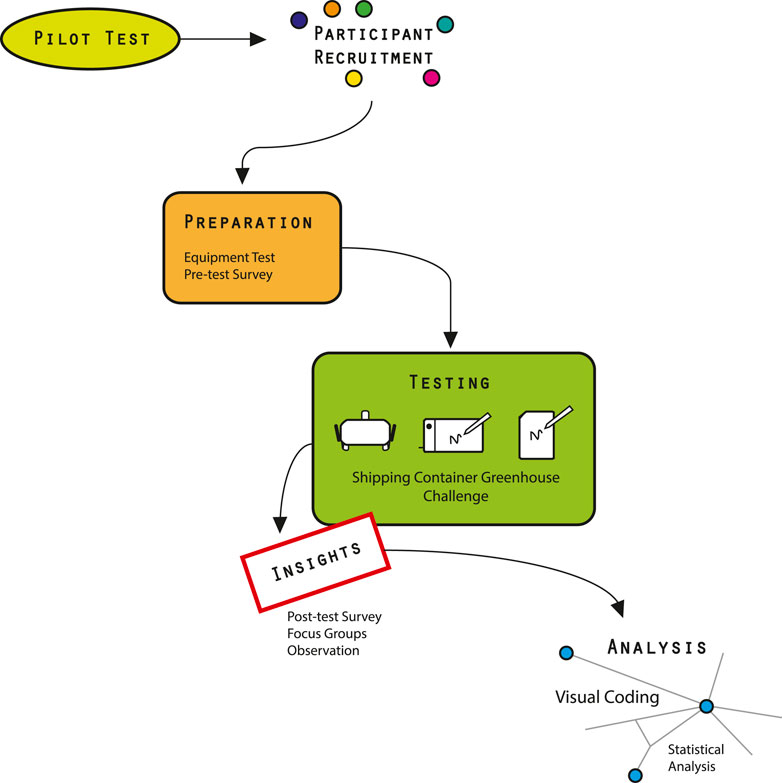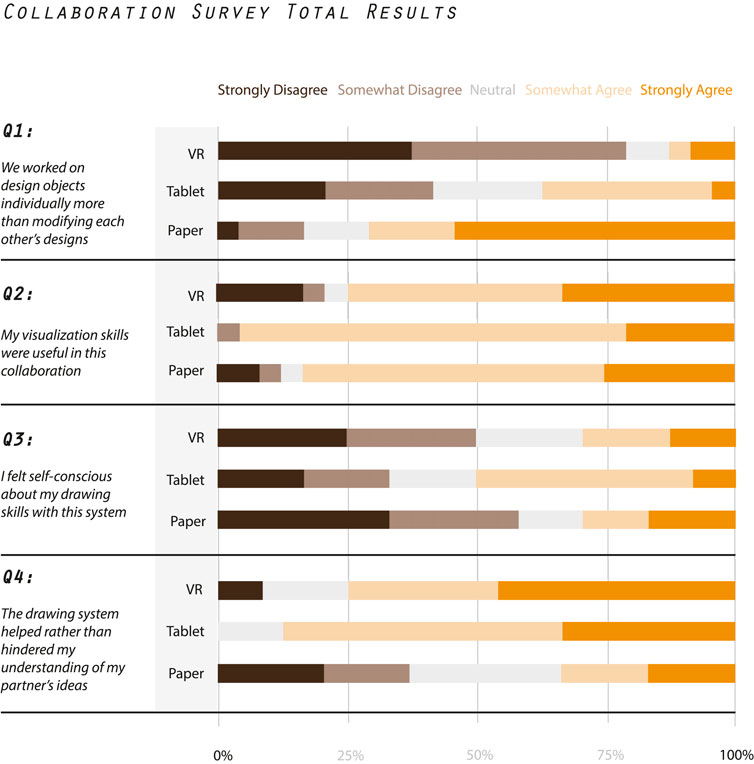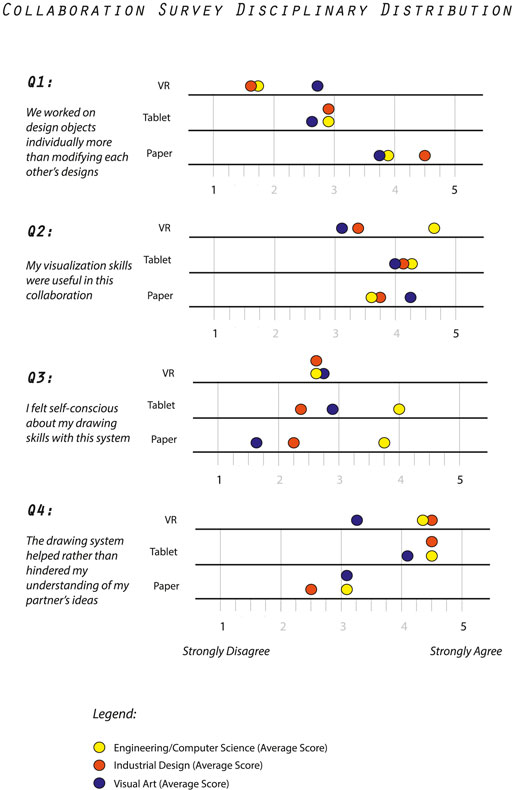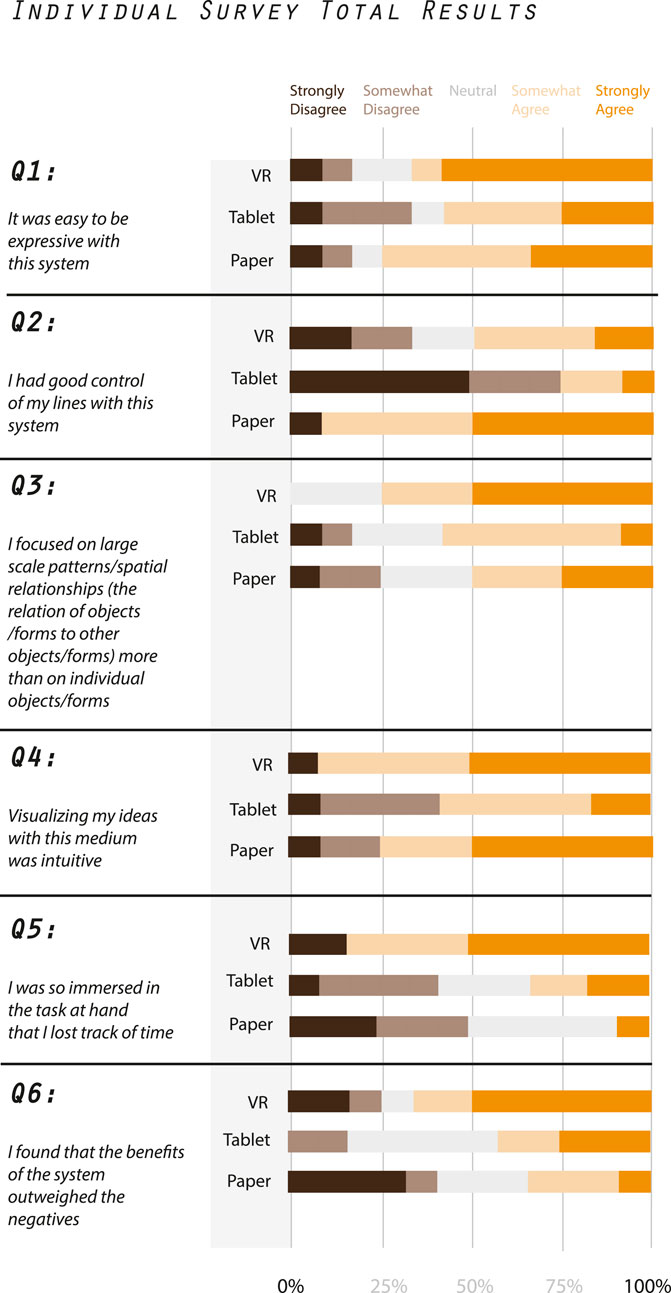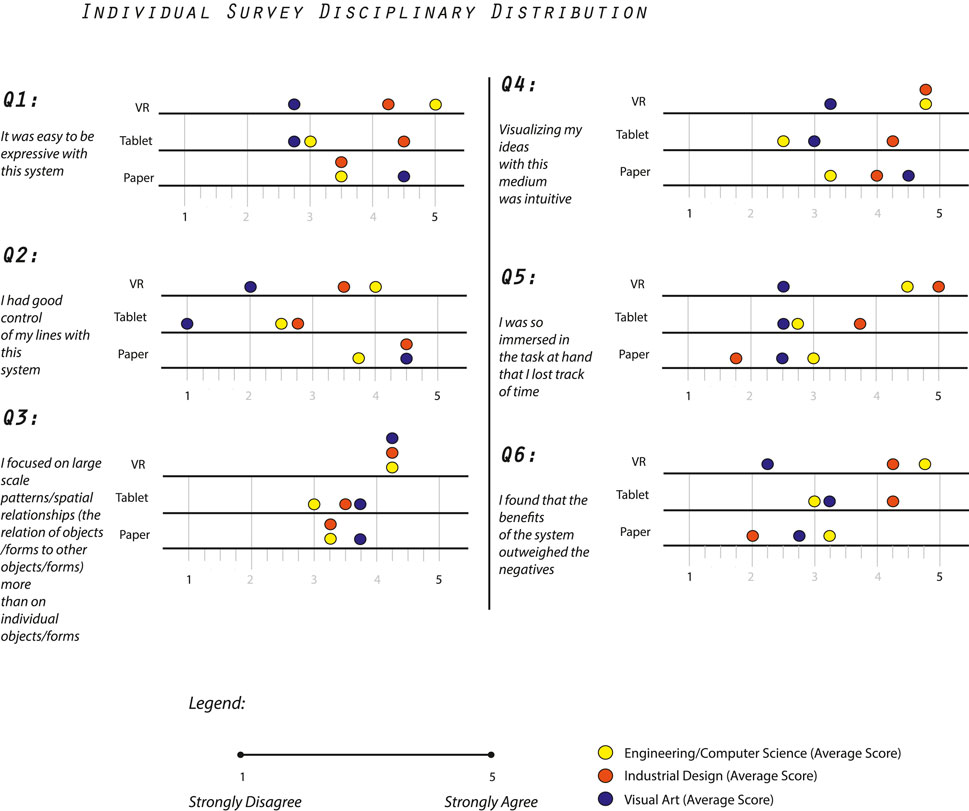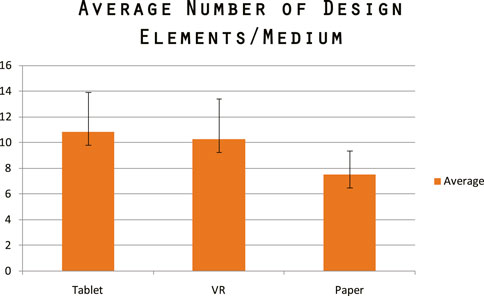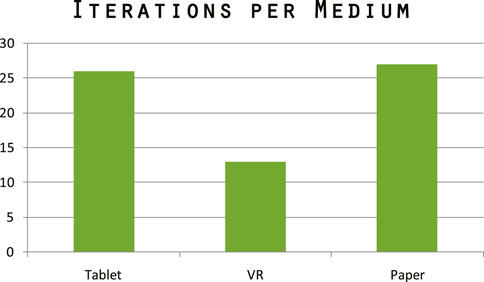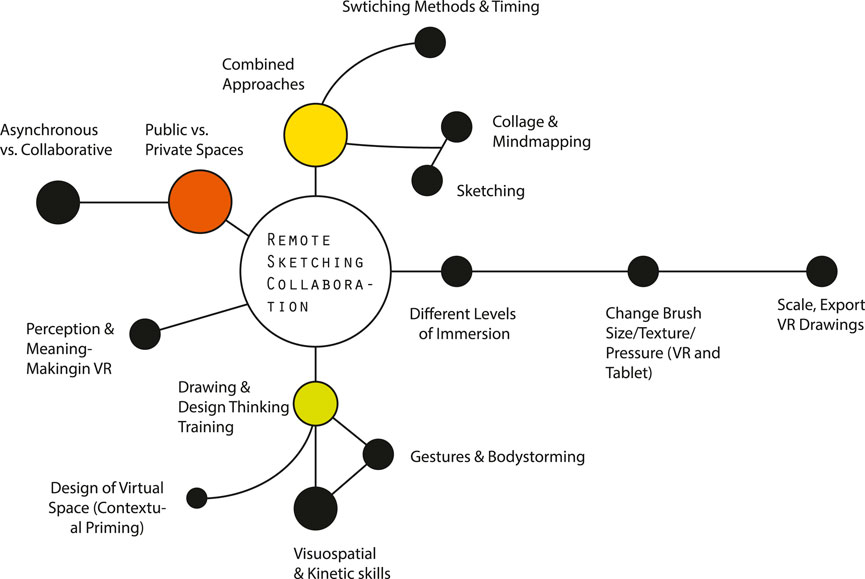- 1Faculty of Engineering and Design, Carleton University, Ottawa, ON, Canada
- 2School of Information Technology, Carleton University, Ottawa, ON, Canada
This study investigated remote multidisciplinary sketching ideation across three systems: virtual reality (VR), tablet drawing, and uploading images of paper drawings. Though cumbersome, expressiveness and line control with drawing on paper was still noted to be important even in remote sketching, particularly by people experienced with this method. The tablet method was user-friendly, fostering effective collaborative understanding, especially in object-based ideation. Existing skills played a significant role in shaping collaborative perceptions. Despite challenges, VR exhibited promise in fostering creative expression and visualization in collaborative design workflows. Notably, it proved beneficial in early problem-solving stages where spatial and sensory considerations influenced structural decisions—potentially useful after general brainstorming and 2D sketching has established themes and objects. This research contributes to further understanding of VR’s evolving role in design thinking, its synergy with other drawing methods in remote sketching collaboration, and the evolving landscape of diverse user needs in ideation processes.
1 Introduction
Making design collaboration accessible to a wider group of users who might not be able to meet face-to-face creates space for a broad range of potential team members who can bring their expertise to complex design problems. These problems might include a dynamic environment with diverse user requirements, technical constraints, and ethical or cultural factors that require the integration of multiple systems, objects, structures, and movements. Our aim for this study was not to find a perfect system that works for every design scenario, but rather to expand the toolkit of geographically dispersed teams of designers (and co-designers), specifically looking at which parts of the design process VR can support the sketching workflow in a case that requires multiple areas of expertise.
As we examined the current tools available for remote drawing collaboration, we asked: are there notable differences in the strategy and artifacts of remote multidisciplinary collaboration when using a drawing tablet, pen and paper and upload, and VR freeform drawing for remote sketching? We compared the benefits and limitations of VR drawing with two types of 2D drawing approaches (tablet, paper and upload), and examined remote collaborative sketching in general. Our experiment assessed tool suitability for various tasks, and analyzed the influence of each method on collaborative synergy and individual ideation. We also specifically investigated the impact of drawing in 3D on the way ideas are communicated. In broader remote sketching exploration, we observed diverse disciplinary approaches, evaluated communication strategies and tool comfort, and examined how skills influenced collaboration. Focusing on collaborative sketching between industrial designers, artists, and engineers in a remote setting, we aimed to identify aspects of the workflow that could be supported by VR drawing and how to leverage digital collaboration characteristics for co-design.
Though there are various brainstorming and ideation methods used by designers, we chose sketching for the study because free-hand drawings and sketches allow for great flexibility, speed, and intuitiveness for communicating ideas in design ideation (Leon et al., 2014). Drawing can be understood as a visual trace of our cognitive processes and it can be seen as a record of how we understand, perceive, and process our experiences (Brew et al., 2013). Virtual reality was chosen because of its usefulness for early design prototyping since the forms are immediately present in 3D; less interpretation could lead to better spatial understanding and cognitive offloading (Jin and Lee, 2019). A drawing tablet was chosen because it allows tactile input similar to analog drawing, but has the benefit of simultaneous collaboration. Because of its immediacy and familiarity, traditional drawing was also important to consider since it is still crucial for non-verbal ideation and communication (Leon et al., 2014).
Some past work has examined multidisciplinary and intradisciplinary (within discipline) collaboration through data representation such as post-it notes, symbols, or scientific data in virtual reality. Other researchers have compared digital ideation strategies (including VR) to their physical counterparts such as sketching or creating lo-fidelity prototypes (Keefe et al., 2005; Rahimian et al., 2011; Diamond, 2019; Oti and Crilly, 2021). To date, no research has specifically compared VR to other digitally mediated sketching ideation methods in a multidisciplinary setting. By analyzing the strengths of each drawing method, we produced guidelines and recommendations for choosing existing or developing future systems for remote multidisciplinary design collaboration.
2 Related work
2.1 Existing design tools and digital adaptation
Maintaining a sketchy aesthetic supports creative fluidity and prevents excessive attachment to a singular idea (McVeigh-Schultz et al., 2018). While traditional desktop CAD (computer-aided design tools) excels in complex problem-solving, these tools come with limitations such as constrained thinking and premature fixation (Veisz et al., 2012). CAD systems compel designers to create an early precise external representation, using highly structured rules that may not align with the spontaneous process of creation (Lee et al., 2018, p. 301). Some researchers have proposed gesture-based input for CAD, but the limitations of using a 2D display to show 3D activities requires designers to use extra cognitive resources (Jin and Lee, 2019).
Tactile feedback is an important part of physical drawing that can also be achieved in tablet or table-based digital drawing. These methods, however, might lack control, pressure sensitivity, and immediacy, and have a longer learning curve to create drawings as effective as pen and paper (Cooper et al., 2009; Evans and Aldoy, 2016). Even though tablet drawing might be harder to control, people can collaborate on the same drawing remotely [Hammond 2015 (p. 103)]. Adding the capabilities of Photoshop, for example, can introduce layering, quick erasure, malleability of size, vivid colour, and minute detail (McGlynn, 2020). This could be especially useful for collaboration.
VR has also been gaining relevance as a conceptual design tool, offering the potential to enhance the intuitive development of ideas in a spatial context, aiding in the meaningful representation of complex design attributes and structures (Yang and Lee, 2020). When used in the early stages of design, it could center the human as a reference point for design challenges where appropriate (Fleury and Richir, 2021). This is particularly relevant as digital tools increasingly embody visual design thinking and cognitive mechanisms (Lee et al., 2018; Yang and Lee, 2020, p. 311). In the early stages, organic approaches seem to maintain fluidity, which is a notable benefit for VR. According to Lee et al. (2018), organic digital sculpting tools provide immediate visual stimuli and increased decision capacity to users, encouraging them to break free from the traditional limitations of CAD. Lack of precision in VR freeform drawing has led to research using tracked tablets, however this has not consistently produced more creative outcomes (Wang et al., 2020; Ying and Heo, 2023).
2.2 Remote co-design and cross-disciplinary approaches
Co-design can refer to the organizing of open innovation processes; this includes both collaboration between people from different organizations or disciplines, or involving users or customers as participants in the design process (Steen, 2013). However, current co-design processes involving these users tend to limit contributions basic proposals of ideas through brainstorming (Fleury and Richir, 2021). The co-design approach “needs to be enhanced by a suitable representation ecosystem that promotes active participation” (Dorta et al., 2019 found in Fleury and Richir, 2021). Co-created projects are fluid and deeply relational, collaboration in these cases often calls for creative thinking skills beyond domain specific knowledge (Leenders et al., 2003; Boy, 2013; Brew et al., 2013; Diamond, 2019; Fitzpatrick et al., 2023).
Though interdisciplinary or multidisciplinary models of collaboration are promising (for example, combining art and science), methodological and epistemological issues raised by this type of collaborative work will arise, especially when collaboration needs to be remote (Brew et al., 2013). Relationships between concepts communicated across several disciplines are different than concepts communicated within the same discipline, and visualization is not innate and takes learning with the specific system or context (Herter et al., 2013).
2.3 Ideation strategies
A study by Cramer-Peterson et al. (2019) reveals that during idea generation, designers primarily use abductive-deductive reasoning. Designers typically use a qualitative and spatial approach, engineers prefer deductive reasoning grounded in quantitative analysis and software tools while artists rely on abductive reasoning, especially for inferring theories from disjointed data (Keefe et al., 2005; Kara and Georgoulias, 2012). Abduction is crucial for design thinking and generating initial ideas across disciplines, while deduction refines these ideas (Steen, 2013).
Crilly and Vasconcelos, (2016) highlights that where designers generate more novel ideas, engineers focus on the practicality of solutions. Zhicheng and Stasko (Liu and Stasko, 2010) observe that even in engineering, however, innovations often arise through mechanisms like analogy and simulative modeling, rather than logical deduction. The interaction between knowledge transfer and visualization in engineering and design remains a largely unexplored area (Avsec and Savec, 2019).
Recognizing distinct ideation approaches across disciplines contributes to understanding how new tools or systems can interact with collaborative processes. Lee et al. (2018) note that 3D sculpting tools foster increased conceptual thinking (active image reasoning and evaluation) compared to conventional sketching, emphasizing the advantage of digital media in the ideation process. Lee et al. (2018) also noticed that while drawing on paper led to more divergent or lateral thinking, using the 3D sculpture tool led to more convergent thinking, such as gradually increasing the complexity and concreteness of the design. This shows that both sketching and organic 3D sculpting tools support different types of ideation, and might be useful in different phases of collaboration (Lee et al., 2018).
2.4 Spatial perception and embodiment
Iterative sketching on paper, as observed by Ban and Hyun (2019), often distorts designs, making them more dynamic, but this distortion (though attractive) could potentially compromise manufacturability. Referring back to a 3D model minimizes this discrepancy (Ban and Hyun, 2019). In a study with a team of architects, Rahimian et al. (2011) argue that collaborative 3D sculpting in virtual reality improves the discovery of unexpected spatial relationships and features while reducing reliance on working memory. Responding to spatial context can lead to less effort in the initial stages of problem solving (Yang and Lee, 2020). Furthermore, Herter, Brown, and Ovtcharova (2013) recommend arranging conceptual models in 3D space for multidisciplinary cases, overcoming visual complexity issues and providing a holistic spatial view. Direct immersion would lend itself well to environmental design, for example, allowing for a realistic perception of future spaces (Fleury and Richir, 2021).
Oti and Nathan (2021) note that immersive 3D sketching in particular remains “undervalued, misunderstood and unused by many designers who view [these tools] as frivolous for serious design tasks.” They argue, however, that 3D sketching in particular can help designers think more carefully about their representations. This intentionality could be important for communication in co-design.
Embodied brainstorming approaches (bodystorming) enhance creativity by leveraging bodily experiences in complex design spaces (Segura et al., 2016). Exploring movement in VR introduces new dimensions, challenging traditional perceptual and meaning-making experiences (Else, 2018). Poulsen and Thøgersen (2011) highlight the fundamental role of embodied expressions in conveying design ideas. This suggests the need for further research into how VR impacts visualization, sketching techniques, and cognitive processes in design thinking, potentially fostering the development of a new visual language (Novoa et al., 2022).
3 Materials and methods
3.1 Study design
The study involved creating mock design ideation sessions to simulate a multidisciplinary collaborative design challenge. Our aim was to evaluate how drawing tools influence strategies and design artifacts for remote teams that involve co-design. Specifically, we were interested in seeing how digital tools like VR could be part of a co-design workflow. We compared 3D VR drawing to two forms of 2D drawing—tablet drawing and paper drawing and upload. We also compared the approaches of people across three areas of study/profession—industrial design, visual art, and engineering (either mechanical engineers or computer science students with experience in software engineering). We evaluated how different skills affect collaboration strategies with these digital drawing methods, how these methods affect participants’ individual visualization and creativity, and the characteristics of 2D vs. 3D drawing when designing a complex space. We decided that the participants would make a shipping container greenhouse for a cold climate, as this is a complex design problem that is not just focused on forms, but on relationships, limited materials, human interaction, and active elements such as growing plants.
This study used a mixed design including observation, surveys, open-ended questions, and focus groups (Figure 1). Participants had equipment delivered to them since the study took place early in the COVID-19 pandemic. They were each responsible for setting up equipment by following an instruction sheet sent out by the researcher. All participants experienced all conditions. There were two independent variables: the medium for collaboration and area of study/profession of the participants. The medium for collaboration had three levels—physical drawing on paper (uploaded to online drawing collaboration site “Conceptboard” via laptop throughout the test), tablet drawing (directly onto Conceptboard), and VR drawing (drawing within the VR space using basic drawing app from Normal VR template).
To analyze what took place during the tests, we collected subjective feedback from participants through a post-test survey and focus groups, and observed design challenges to extract a qualitative and quantitative evaluation of performance in each condition.
3.2 Participants
Twelve participants in total were recruited for this study from the Faculty of Engineering and Design at Carleton University (Ottawa), and the Scenic Art Department of IATSE Local 828 (Toronto) via email and snowballing. Four participants were selected from each of the following disciplinary categories:
1) Engineering (including software engineering or computer science)
2) Industrial design
3) Visual art
The participants were in the age range of 21–41 with an average age of 30. Of the twelve, two were undergraduate students, five were graduate students, and five were professionals.
As a case study of people from different disciplines, our objective was to uncover the types of changes or characteristics in the design process noted across systems during a multidisciplinary collaboration rather than draw conclusions about the disciplines. We chose each area of expertise to bring different types of visualization backgrounds and perspectives to the design process, though we note that the areas chosen are only samples and not fully representative of a realistic multidisciplinary design scenario. We considered engineering and computer science part of the same category for the purposes of this study because they both traditionally use deductive reasoning in day to day tasks for their discipline (though not a rule) (Kara and Georgoulias, 2012). The computer science participants also had experience in software engineering. The study did not require the participants to have any experience in any CAD software or drawing. The participants were also not required to have any experience in VR or computer gaming. The varying level of experience with VR and CAD was considered representative of a co-design situation with diverse stakeholders (Figure 2).
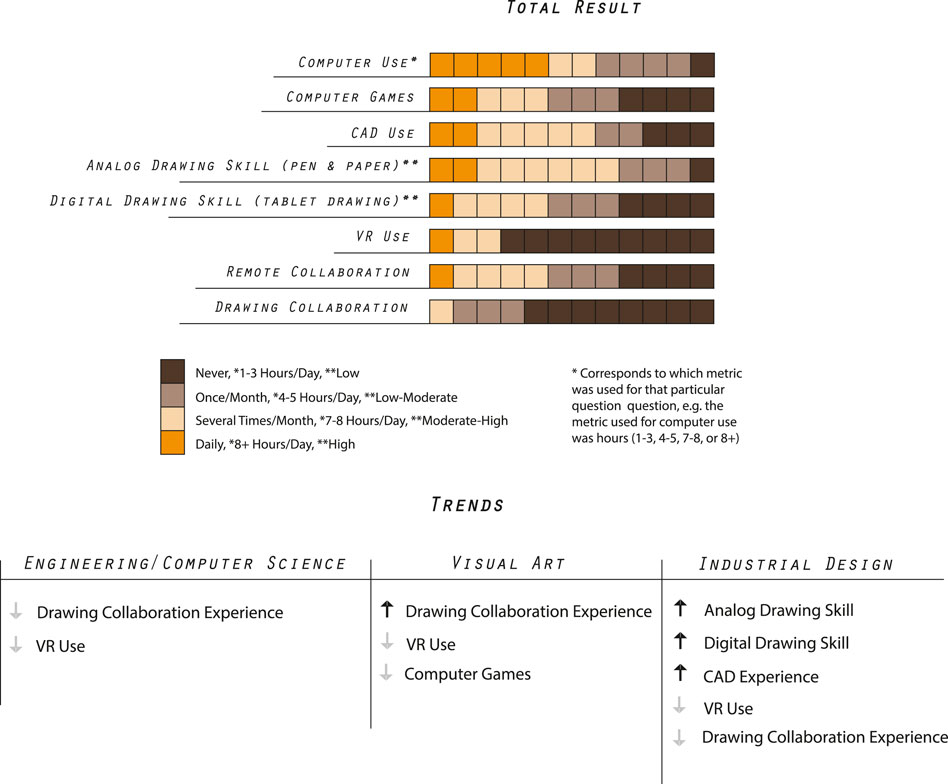
FIGURE 2. Pretest survey results, trends in pretest survey results (upwards arrow—upwards trend in experience).
3.3 Apparatus
The following is a list of items used for the study. There were two sets of equipment that were delivered in boxes to participants on the day of their testing.
Hardware:
• Oculus Rift CV1 headset, sensors, and controllers
• VR-ready laptop with the following specifications: Intel Core i7-7700HQ CPU, an NVIDIA GeForce GTX 1070 GPU, and 16 GB RAM
• Drawing tablet–XP-Pen G430S
Smartphone (supplied by participants)Software:
• VR: Multiplayer drawing application (based on Normal VR drawing app with multiplayer plugin)
• Tablet and Paper: Conceptboard (collaborative online drawing app)
• Skype
Other Items:
• Paper for analog drawing condition.
• Each participant also used a desk or table and had a clear space in their room to walk around for VR condition.
3.3.1 VR collaboration: basic drawing application (normal VR)
We considered several current drawing applications available for the Oculus Rift. Most did not have a multiplayer option, used prismatic shapes such as cubes to create scenes, or included scene items such as stylized avatars, animals or backgrounds which would have added variables to our study. We wanted the drawing app to be as simple as possible, so we chose to build a basic application for the freeform VR drawing condition. It was created from a template from Normal VR using the Normcore multiplayer plugin (Figure 3). This particular app design was chosen because it is a very basic version of a drawing app with a gridded floor and empty space. The app was made using Unity and was kept virtually the same as the template aside from removing several items such as blocks that were in the scene. It included basic avatars that included a black sphere for a head and black egg shapes for hands. The app allowed participants to walk to navigate the space, and to leave marks in space.
The method of drawing afforded by this app was leaving “ribbons” or lines in space when the index button of the controller was pressed. To maintain our focus on the fundamental aspects of the sketching process (strategy, structure, and spatial movements) and limit the amount of variables, erasing and changing brush size or colour was not allowed in any of the conditions. Freeform sketching in VR was chosen to maintain the loose, sketchy aesthetic that is known to reinforce creative fluidity (McVeigh-Schultz et al., 2018).
3.3.2 Tablet and paper collaboration: conceptboard
This collaboration site mimics a whiteboard, where multiple people can collaborate in real time on the same board. Similar to the basic VR drawing app, it was an empty space with a lightly gridded background (Figures 3, 4). It provided the capability for real-time drawing, zooming in and out, erasing, creating shapes, and uploading photos. For this particular study, real-time sketching using only the pen tool was used for the tablet condition (without changing brush size and colour throughout the study) to maintain consistency with the VR condition. Uploading photos of drawings was the only action used for the analog drawing condition. There was also a symbol that indicated where each person’s mouse was that changed in real-time when the person moved it.
The following is a list of the scenarios and hardware/software used in each:
Scenario 1. Virtual Reality Freeform Drawing
Hardware: Oculus Rift CV1, laptop
Software: Multiplayer drawing app (Normal VR)
Scenario 2. Tablet Drawing
Hardware: XP-Pen G430S Drawing tablet with pen stylus, laptop
Software: Conceptboard
Scenario 3. Paper Drawing and Upload
Hardware: Smartphone (for camera), laptop
Software: Conceptboard
Other Items: Paper and sharpies
3.4 Procedure
The study took place over the span of 2 weeks, with focus groups the following week. The studies were all conducted remotely across several different cities (Ottawa, Greater Toronto Area) and were recorded via real-time screen recording of Skype calls. For the VR sessions, the Oculus Rift was connected to each participant’s laptop and the session was also shared and recorded in real-time via Skype. After recruitment, the procedure went as follows:
1) Scheduling (pickup/dropoff of equipment, pretest survey)
2) Testing (Skype briefing, screen and audio recording, post-test survey)
3) Focus Groups (several 30 min long focus groups, 15 min long extra sessions for scheduling conflict)
Each participant completed two full rounds of testing—each with a partner from a different discipline. The test was comprised of three 10 min segments—each with a different design medium and slightly varying design challenge. The design challenge was to create a greenhouse for an arctic or cold climate with a harvesting path and some form of lighting. The variations included a soil-based, hydroponic and aquaculture based greenhouse. We opted for slight variations in design sketching activities while adhering to similar conceptual frameworks, aiming to have a similar design process across activities. These design challenges as well as the medium (VR/tablet/paper) were counterbalanced. Participants were able to communicate using audio in the same way across each condition.
A pretest survey collected information on participants’ backgrounds, experiences with specific digital media, and prior collaboration experience. After the design sessions, post-test surveys and focus groups collected data about the experiment. The data was later analyzed using visual coding and statistical analysis.
The post-test survey comprised two parts:
Part 1 (A) focused on collaboration and assessed participants’ experiences within the collaboration process. Each participant completed this section twice (in Survey 1 and Survey 2), resulting in 24 responses per condition (VR, tablet, paper) for four specific questions. Using a 5-point Likert scale (1 = strongly disagree, 5 = strongly agree), responses evaluated aspects like individual design work, visualization skills’ relevance, self-consciousness about drawing abilities, and the system’s impact on comprehending partner ideas.
Part 2 (B) focused on individual ideation and consisted of six questions exploring participants’ perceptions of individual visualization and ideation processes. Each participant responded once, resulting in 12 responses per question per medium. Questions gauged ease of expression, control over lines, focus on spatial relationships versus individual objects, intuitive use of the medium, immersion in tasks, and weighing the system’s benefits against its negatives
4) Focus Groups and Open-ended Questions
Open-ended questions at the end of the survey and focus groups obtained positive and negative feedback about each system, as well as ideas for future systems. Feedback included ideas on individual use of the systems as well as social interaction with digital media.
5) Observation
Qualitative and qualitative data were obtained from observing video and audio-recordings of the collaboration sessions. We tallied the amount of design ideas as well as iterations made while using each medium. During this observation, we considered a novel design element any new object or idea that was sketched, whereas an iteration was considered a modification or redraw of any of the existing design elements. Qualitative observations included the kinds of interactions during the collaboration sessions as well as trends noticed in strategy or actions as well as notable statements by participants or struggles they had during the ideation sessions.
4 Results
The following areas were evaluated after data was collected from surveys, observation, and focus groups:
Surveys
Collaboration (creative synergy, communication of ideas, and self-consciousness)
Individual Ideation (creative expression, control of lines, visualizing objects/relationships)
Observation
Strategy and Artifacts (Types of iterations, amount of iterations, outcome of the design process)
Focus Groups and Open-ended survey questions
Drawing and Tactile Media (perception of importance)
Efficiency (ease of use, appropriateness of methods)
Spatial Relationships and the Design Process (types of ideas, responding to 3D sketches)
Social Interactions and Co-design (accessibility, movement and the body, emotional elements, supporting capabilities)
4.1 Surveys
4.1.1 Collaboration
The responses to whether participants worked on design objects together or individually (Q1A) indicate that overall more people thought that they worked on design objects together in the VR medium and that they felt like there was less modifying of each other’s ideas in the paper condition, with the tablet condition sitting somewhere in the middle. The indications of these results support the hypothesis that the VR condition could improve the collaborative synergy during the design process (Figure 4).
The tablet condition was rated higher in usefulness of visualization skills (Q2A) as almost all participants found their visualization skills to be useful, though the other two media were not drastically far behind. Notably, more visual artists disagreed with their visualization skills being useful in the VR condition
The differences between media did not differ drastically in terms of perceived self-consciousness (Q3A). Most of the people who felt self conscious in the tablet condition were engineers, whereas most people who did not feel self-conscious in the paper condition were artists. VR was expected to help the most in understanding of ideas (Q4A), however the tablet system scored higher, though it was followed closely by the VR condition, whereas the paper drawing and upload condition scored much lower.
4.1.2 Individual visualization
Two Friedman tests examined differences in creative expression scores (Q1B, Q4B, and Q5B) across conditions (VR, tablet, paper) (Figure 6). The first test, analyzing scores for all participants, revealed no statistically significant difference (χ2 = 2.33, p > 0.05) in creative expression across conditions. However, a subsequent analysis focusing solely on industrial designers and engineers displayed a significant difference (χ2 = 9.66, p < 0.05) in creative expression scores across conditions. This finding indicated a significant disparity in how these groups expressed creativity using VR, tablet, and paper mediums (Figure 7).
Further post hoc analysis using a Fisher’s Least Significant Difference Test using data from only the engineers and designers determined that the differences between all conditions were significant with the difference between the VR and paper condition to be the greatest in difference [
The scores for line control (Q2B) in both the tablet and VR approaches was not as low as expected: four participants felt they lacked control in VR while six believed they had control. Regarding thinking about large scale patterns or spatial relationships (Q3B) the anticipated similarity between the VR and tablet approach was somewhat confirmed, with VR showing a slight advantage in holistic spatial reasoning. When evaluating system benefits vs drawbacks, eight participants supported VR (two strongly disagreed), five supported tablets (two disagreed), and four supported paper (four strongly disagreed). Three out of four artists did not think that the benefits of the VR system outweighed the negatives, and three out of four engineers did not think that the benefits of the tablet approach outweighed the negatives.
4.2 Observation
4.2.1 Strategy
Quantitative observations
While using the tablet medium, the average amount of new design elements was 10.8 per session (130 total for all tablet tests). The average amount of new design elements in the VR medium was 10.3 new elements per session (113 total elements for all VR tests, 124 with an added average score for one test where we were not able to get data for this condition), and 7.5 in the paper condition (90 new elements total) (Figure 8). Though more ideas were created in the tablet system, the VR approach was not far behind, whereas the paper condition has much fewer ideas than expected. A one-way ANOVA was conducted to check if these results were statistically significant. The results showed that there is a statistically significant difference among the media conditions (F(2, 33) = 5.00, p = 0.01). A Tukey’s Honestly Significant Difference (HSD) post hoc test was conducted that revealed statistically significant differences between the paper and tablet groups (mean difference = 3.33, p < 0.05) and between the paper and VR groups (mean difference = 2.77, p < 0.05). However, no statistically significant difference was found between the tablet and VR groups (mean difference = −0.56, p > 0.05). The low amount of design elements in the paper approach may have been influenced by the slow upload speed to the app, so it is important to note that context and technical limitations could have influenced this result.
The amount of design elements created was also compared across disciplinary pairings. The artists and engineers came up with slightly less novel design ideas during the collaboration than the designers and artists or the engineers and designers. Both of the latter collaborations had a similar amount of design ideas at an average of 29 (116 total) and 29.75 (119 total) respectively whereas the engineers and artists had 24.5 (98 total) (Figure 9). A one-way ANOVA was also conducted on these results, it indicated that there was no statistically significant difference in the average number of new design elements among the three disciplinary pairings [F(2, 9) = 0.59, p = 0.56]. Each collaborative pairing was almost exactly equal in the amount of modifications or redraws of certain design elements [22 (artists and designers), 23, 23]. Across media, however, we noticed that there was a difference: in VR there were notably less total iterations than the other two methods (13 compared to 27 for paper and 26 for the tablet approach) (Figure 10).
Qualitative observations
In the VR condition, there were cases where participants placed themselves in the shoes of someone who would be using the space. For example, participant 8 (designer) wondered if a ladder would be needed to reach the top shelves or if it would be accessible while standing, and participant 7 (artist) crouched down to enter the door of the greenhouse they created (Figure 11). In addition to this, several participants waved to each other in VR and virtually hugged. Since the greenhouse was meant to be a public space, in the VR condition participant 10 and 11 (engineer and artist) added a decorative feature in the tank, a place that is not public access for storage and caretakers, as well as an entrance area to keep the cold out, and a bench. Other suggested items included jet packs, skis or a continuous track to make the greenhouse mobile.
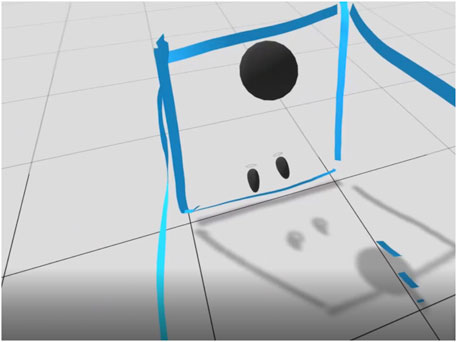
FIGURE 11. Gesture Communication (Crouching through doorway, Collaboration Between participant 7 and 9—Artist and Engineer).
Several participants (of all three disciplines) began the process by sketching the shipping container shape first to create a boundary, using the grid on the ground for guidance. Developing a strategy like this for the drawing beforehand was important for some participants, and they saw the process as less about brainstorming or ideation and more about the output or illustrating what they already know. For example, participant 9 (engineer) developed a drawing strategy for his first collaboration and carried this through with much similarity in the second one (across all media). Participant 7 and 8 (artist and designer) adopted a similar strategic approach. In some cases, a strategy developed for other reasons. For example, participant 4 noticed that the first time they had drawn too big and they did not have the room to finish their drawing, so for the second time, they suggested drawing a smaller scale model of the greenhouse in VR. Another action/strategy was the intention to label specific parts of the design (Figure 12). Aside from labeling items, this also included notations such as dashed lines, and arrows in the VR, tablet, and paper approach. There were also some moments that were more spontaneous than strategic, such as noticing details in size and shape of the drawings that influenced participants to add items or expand sections.
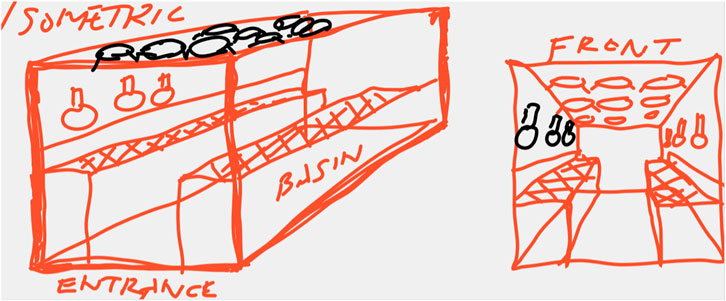
FIGURE 12. Labeling parts of the design (collaboration between participant 7 and 9—artist and engineer).
Participant 10 (engineer) and 12 (designer) used the paper condition closest to how the researcher intended, as they uploaded pictures frequently throughout the collaboration process to show the other participant what they were thinking (Figure 13). From here they modified their designs and created new iterations. Other groups such as participant 7 (artist) and 9 (engineer) did not use this approach as intended, and only uploaded a couple of photos of designs they worked on individually through the process.
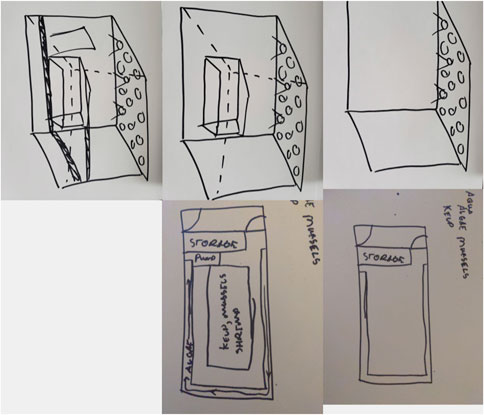
FIGURE 13. Sequential collaboration via paper approach (collaboration between participant 10 and 12—engineer and designer).
Several participants were observed to draw shaky lines that were not level or well connected. There were, however, several participants (7 and 10) who created straight and proportionate lines. As observed in the survey results, control of lines in the tablet approach was overall poor. The people who were most comfortable with this approach were people who had used tablets often in the past (in this study these were mostly industrial designers).
4.3 Focus groups and open ended survey questions
The following themes developed through analyzing responses to open-ended survey questions and focus group discussions:
4.3.1 Drawing and tactile media
Participants’ feedback on different types of media for ideation, and the importance of analog approaches varied. Artists in this study were the most critical of the VR condition and preferred paper/analog approaches. They also emphasized the immediacy of physical media and the value of sharing drawings via video stream for collaboration (participant 1 and 11). Some artists (particularly participant 1 and 4) preferred to avoid technology, finding that their art practice is more accessible and fulfilling without it. Participant 4 stressed the importance of cross-sensory experiences. Engineers expressed enthusiasm for the VR approach and pointed out the potential for skill development with digital tools. Some argued that collaboration and real-time work were easier with digital media, for example, participant 5 noted his lack of attachment to tactile media, and participant 2 said that when “we get used to the other drawing tools, the VR and tablet will be more effective.” Industrial designers appreciated both the tablet and VR approach, but highlighted the practicality of the tablet. Some found physical drawing important but it was not a deal-breaker. Participants recognized generational differences in perception of technology, with some people resisting the use of digital tools due to educational/professional background and preferences.
4.3.2 Efficiency
The following points were noted on the ease of use, comfort, learning curve, and effect of different types of media on ideation approach.
Tablet
The tablet was generally considered the easiest method for this experiment, with Participant 8 (designer) describing it as intuitive, communicative, real-time, fun and engaging, and “by far the easiest method for this experiment.” Participants found it practical, especially for real-time 2D drawing, particularly for collaboration. Some positive aspects included its synergy, practicality, convenience, simplicity, and speed. However, there were also some negative aspects noted, such as difficulties in use, clumsiness, messiness, and annoyance. Participant 11 (artist) suggested that in certain early brainstorming scenarios, a 3D approach might not be necessary, particularly if someone can visualize 3D in 2D. Participant 5 (engineer), however, found that while he liked using the pen with the tablet, he did not find it particularly enjoyable or accurate. Participant 10 (engineer) highlighted the challenges of expressing ideas due to his unfamiliarity with the tool, while Participant 3 (designer) noted that using a tablet led to messier sketches, likely due to a learning curve. Furthermore, Participant 10 (engineer) believed that a different tablet style with direct image presentation on screens and the ability to upload photos could enhance the experience.
VR
Participants found the VR approach fascinating, immersive, engaging, intuitive, easy to use, fun, and novel. Other positive aspects include the ability to use hand gestures and body movement for communication. However, there were also negative aspects, such as it being messy, disorienting, limiting, finicky, and occasionally jarring. Participant 1 (artist) found it challenging to connect lines and create in a vacuum-like space, and she anticipated a long learning curve. Some engineers and designers, however, highlighted that using VR required less effort because it allowed for a more natural representation of angles and spatial dimensions. Participant 10 (engineer) appreciated how easy it was to navigate the VR space since the dimensions are present, unlike the tablet or paper approach.
Participant 3 (designer) noted that when there were no technical difficulties in VR it was “awesome, it flowed really well, and we bounced ideas off each other well.” She thinks that VR will be a necessary tool since being able to do more creative exploration without making expensive prototypes can save time and money. Participant 7 (artist) noted that all the ingredients exist for VR to be a useful remote collaboration tool but things just need to be put together. It seems “natural and obvious” to him, and that the biggest challenge currently is the user interface. Further challenges specific to this experiment include the lack of an ergonomic pen, the inability to change brush types or erase, navigation difficulties, and physical boundaries [as noted by Participant 5 (engineer) and 6 (designer)]. Participant 7 (artist) also noted that it should be easier for people who are not programmers to create or modify the environment or tools for their specific needs.
Paper
The paper approach was generally seen as cumbersome, clunky, individualistic, isolated, slow, awkward, and less enjoyable. However, it was also noted to be easy, efficient, comfortable, familiar, reliable, traditional, and accessible. Participant 4 (artist) considered it valuable alongside the tablet. Participant 7 (artist) mentioned limited iteration (potentially related to the process of uploading). Participant 10 (engineer) also noted that though it was relatively easy to communicate with this method given his familiarity with the tools, though his ability to draw things that look 3D on paper are poor compared to orthographic projection (most drawings produced during the collaborations were in 3D perspective).
4.3.3 Spatial relationships and the design process
Some hurdles that were noted in the design process in general include struggling with getting a sense of scale, the limited time, and communication and hurdles of working with a new person (noted by participant 8—designer). All participants recognized that mastering the VR and tablet tools would take time.
Participant 5 (engineer) noted that the types of ideas that you could convey were different across media. He felt that the crazier ideas were more natural to convey in VR. Participant 2 (engineer) also noted that seeing in 3D changed the design process because partners could check each angle at the same time, and the dimensions are present so it is more straightforward with less interpretation. Participant 5 (engineer) felt that in VR he could express and illustrate his ideas on a much larger and more interactive scale that he could not do before. Participant 4 (artist) noted that working in 3D definitely changed the design process for him, participant 3 (designer) also thought that the human scale of VR was an asset as it was easy to be in the place they were designing. Participant 5 (engineer) noted that when he drew in 3D, he felt he could notice subtle spatial details—“since your brain is thinking naturally you can respond to something as if you were in that space, without having to interpret and imagine everything.”
Being able to see people’s hands and make gestures in VR was a “playful element” that both participant 1 and 11 (artists) found important. Participant 2 (engineer) noted that having different designers in the same room in VR “will help a lot for group discussion.” Though she was more supportive of incorporating analog media, participant 11 (artist) noted that she experienced a moment in VR where her partner and her were drawing different parts of the shape and joined it together to complete it—this moment of synchronicity stood out to her. Participant 1 (artist) noted that he started to feel embodied towards the end of the collaboration but is not sure how far it can be taken without experiencing technical glitches.
4.3.4 Social interaction and co-design
Participants made miscellaneous observations about the test in general. Both participant 7 and 10 (artist and engineer) noted that working with someone who had a positive, open and curious personality significantly helped the collaboration process. Participant 7 (artist) was surprised that the verbal part of the collaboration and developing strategy was a very important aspect of the coordination of effort and division of tasks. Participant 4 (artist) saw it as working towards an output (creating drawings) and that she was missing the tactile and human element, and participant 11 (artist) felt that some parts of the collaboration process were stilted and that they were not working towards a common goal. Participant 8 (designer) observed that in the VR condition, participants tended to decide quickly what to draw and spent less time brainstorming.
Participant 5 (engineer) thought VR was “so much more fun and open” and he could even tell his partner’s personality through their movements (slow and relaxed vs. excitable). He mentioned video calls are just pictures on a screen whereas in VR you can see actual 3D gestures and it was more intimate. Participant 4 (artist), however, noted that the type of design process that might work very well for someone might be terrible for someone else. She also said that videos and gestures are important and that it is hard to gauge a reaction from just a voice or in VR. She also noted that she would struggle to work in some of these ways because it is not indicative of her abilities.
Participant 7 (artist) emphasized VR’s future networking potential for distributed communities in collaborative projects. Participant 4 thinks VR can be a useful tool for art and design or connecting things, but she has her reservations about its accessibility; she thinks that using it as is would lose a whole group of people that might work best in the tactile way. Participant 7 (artist), however, noted that currently there is no seamless experience with any kind of remote collaboration method; it is all clunky in some way. Participant 1 (artist) mentioned that VR might be useful for people who are not able-bodied, and that perhaps this can give them more abilities in the design space. Participant 11 (artist) also noted that this type of system could be important for assisted imagination or assisted empathy to simulate an experience that a designer might not actually have. Participant 11 (artist) suggested incorporating different types of visual working to an existing online tool like Google Docs. Participant 7 (artist) highlighted the distinctive feature of time-based drawing in VR—for him it was not just about creating marks, but about leaving marks within physical space over time. To convey the completeness of an idea, he stressed the necessity of incorporating movement or a performative element (Figure 14).
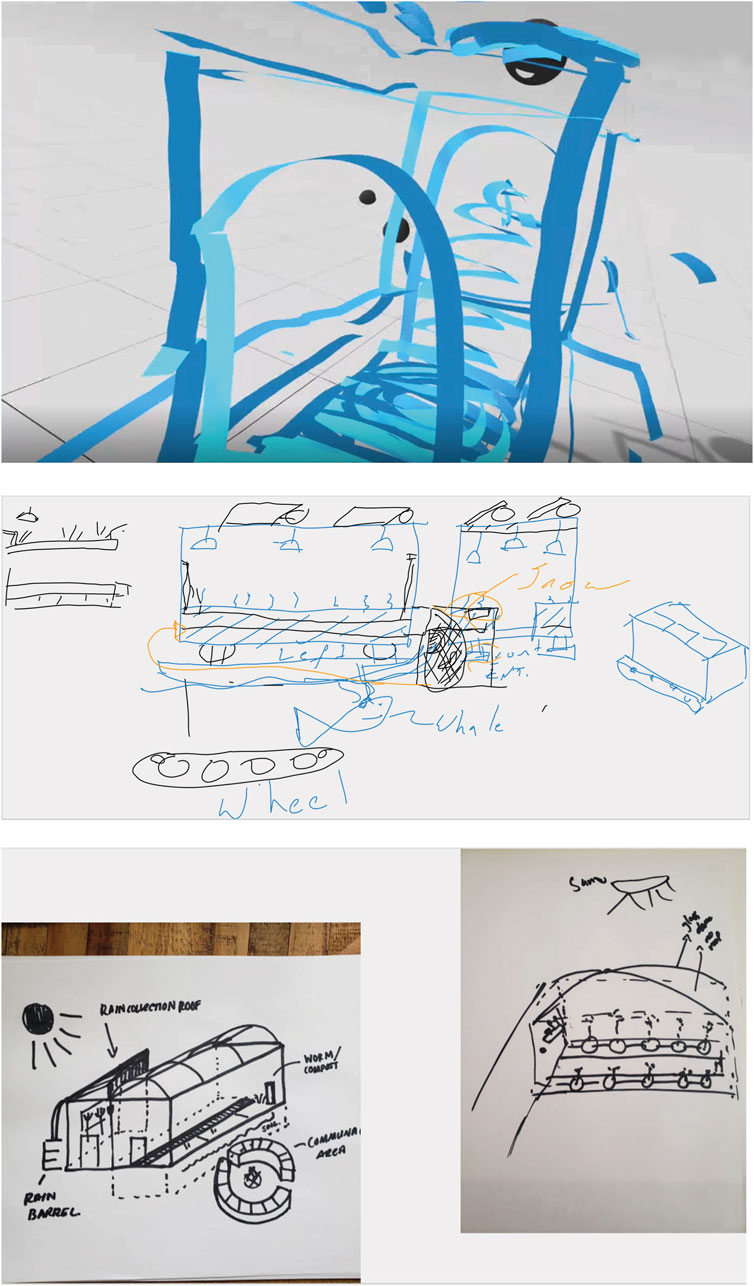
FIGURE 14. Sample collaborations (from top: Engineer and artist, engineer and designer, artist and engineer).
5 Discussion
The following discussion highlights results from across all data collection methods sorted into the following themes:
Social Interactions and Co-design
Individual Ideation
Strategy and Artifacts
Drawing and Tactile Media
Efficiency
Spatial Relationships and the Design Process
5.1 Social interactions and co-design
The tablet method was most useful in helping participants understand their partners’ ideas in this experiment (87.5% agreed compared to 75% for VR and 33.3% for the paper approach). It was also noted that participants’ visualization skills were most useful with this method in a collaboration setting. In the tablet approach 95.8% of participants agreed that their visualization skills were useful. VR scored low in usefulness of participants’ visualization skills (75% compared to 95.8% for the tablet approach and 83.3% paper). The impact of existing skills on collaboration perception is crucial when considering the introduction of new approaches; highly skilled individuals may struggle to adapt their preferred methods to new ones, potentially affecting their efficiency and attitude towards unfamiliar media. New methods should be introduced at a time when challenging established skills can yield tangible benefits to the design process.
It was noted in open-ended questions as well as surveys that VR was highly collaborative (79% worked on design ideas together compared to 41% for the tablet approach and 16.7% for paper). This indicates that while drawing in VR, participants focused on designing and elaborating on the same object together over time. Convergent thinking in this context involved participants actively focusing their attention on a shared object, combining efforts on the design. This type of convergent thinking can be important when evaluating, and making connections to an environment (or people within it) (González-Zamar et al., 2020).
5.2 Individual ideation
Areas where physical drawing excelled were in expressiveness (75% compared to 66.7% for VR and 58.3% for the tablet approach) and control of lines (91.6% agreed they had good control compared to 50% for VR and 75% of participants noting that they had poor control of their lines with the tablet). In terms of overall areas of creative expression (Q1B, 4B, 5B) including expressiveness, intuitiveness of visualizing with the medium, and losing track of time [a potential characteristic of flow] (Tan et al., 2015), VR excelled. A statistically significant difference was found when combining scores for these questions across conditions for designers and engineers.
While artists in this study rated VR lower than other participants, suggesting a potential misalignment between the medium and their skill sets, it is noteworthy that VR was generally perceived as intuitive for visualizing ideas, even by those with no prior experience (91.6% agreement in surveys, supported by focus group discussions). Since there is a lack of established pictorial conventions and best practices in VR compared to traditional paper drawing, this could explain why some individuals, including artists, did not find their visualization skills as immediately useful in this medium. This lack of established norms underscores the potential need for longer timeframe experimentation and evolving approaches to understand optimal techniques to include VR drawing as a useful technique in a co-design toolkit.
Furthermore, stroke-based immersive 3D sketching is widely assumed to be insufficient for the representation of 3D shapes, “based on the assumption that precision is more important than flexibility” (Oti and Nathan, 2021). Oti and Nathan, (2021) show this assumption does not hold for visual thinking and visual communication. They suggest that the value of stroke-based VR sketching is in its capacity to “challenge participants to think more carefully about the representation and visual communication of 3D shapes.” This emphasizes the importance of challenging established norms for advancing drawing and visualization skills.
5.3 Strategy and artifacts
The study revealed similarities in the generation of new design elements between the tablet and VR approaches (10.8 and 10.3, respectively, compared to 7.5 for paper). While the tablet approach fostered almost as many iterations as paper (26 vs. 27), VR showed fewer iterations (13), although this difference was not statistically significant. Notably, while using the tablet approach, 58.3% of participants focused on examining relationships between design objects, compared to 75% for VR and 50% for paper and upload. Combined with observations, this suggests that the tablet might be beneficial for object-based ideas or conceptually evaluating what is to be put in the design space whereas VR aids in spatial and formal evaluations within complex design scenarios. In addition to physically responding to the space (e.g., crouching and reaching) an observed strategy in VR involved creating boundaries and progressively developing shapes within them, indicating a potential strategy for gradually converging design ideas (Lee et al., 2018; Lee, 2020). However, further testing is required to confirm these results due to factors such as tool familiarity, spatial constraints, and brush stroke sizes that could influence participants’ confidence with the tool.
Despite the paper system being described as separated and annoying for this test, it facilitated independent iterations leading to ideas that diverged from each other compared to the more collaboratively oriented VR and tablet methods. Variations in reasoning styles might also influence design strategies (Lee et al., 2018), as people who used deductive reasoning tend to modify predetermined ideas sequentially, while people who use inductive reasoning explore ideas non-sequentially(Lee et al., 2018). This underscores the necessity for further exploration, especially within disciplines, to understand the impact of reasoning patterns on multidisciplinary design processes, particularly in the context of digital systems like VR. Additionally, the observed use of sketching more for illustrating design ideas than as a brainstorming method across all media reinforces the need for design thinking training and specific media training for all collaboration members, but also could be partly due to the way the study was conducted and the lack of emphasis on the goal of drawing as brainstorming.
5.4 Drawing and tactile media
The perspectives of artists who intentionally distance themselves from technology underscore the skepticism that experts in a craft may harbor toward new, complex technologies (McGlynn, 2020). Acknowledging and valuing such perspectives is crucial, as the suitability of more complex technology is not universal. The study emphasizes the importance of questioning the appropriateness of a specific medium, considering philosophical and semiotic implications, and evaluating its impact on emotion and the creative process. This inquiry gains significance when applied to individuals without prior experience with computer-aided design (CAD) or digital tools in remote co-design scenarios. Exploring how individuals’ perceptions and attachments to media influence their creative processes becomes essential, particularly considering varying backgrounds and experience in a technocentric society.
5.5 Efficiency
5.5.1 Tablet
Though the tablet may have produced less polarizing views or enthusiasm as the other methods in this study, it was practical and easy to use; for some early ideation sessions, this method might be enough. Participants who had the most experience using tablets in the past felt the most comfortable with it (industrial designers), whereas participants who did not have experience using it felt the most frustrated at their inaccuracy with their lines.
5.5.2 VR
Though it was difficult for some participants to connect lines in this condition, some noted it was easier to navigate because the dimensions were present. This led to more realistic design decisions. Engineers in this particular study were unanimously supportive of the VR approach. This could be due to their higher comfort level with technology (such as more computer games played—three out of four play several times per month whereas three out of four of the artists never play), less attachment to the semiotic or conceptual significance of the media, and more interest in the capabilities or efficiency of the media. Similarly, as Lee et al. (2018) note, people who favour subsequent evaluation or a deductive reasoning approach in the design process tend to make decisions outside the functional or aesthetic influence of the digital tools through the design process. According to Lee et al. (2018), the functional or aesthetic properties of the tool might therefore have a greater influence on the creative process of people who use abductive reasoning more frequently (e.g., artists).
5.5.3 Paper
The analog drawing approach also stood out in some areas such as familiarity, accessibility, and tactility, as well as amount of iterations. The system of uploading, however, was cumbersome and less collaborative than the other approaches since participants could not draw in the same space/same board. Some artists also indicated that the tactile aspect of analog media is still important as a lot of people feel most comfortable working this way, so it could still be a useful part of a remote collaborative design setting when combined with another real-time approach. The high level of control in the paper method is another strength that is important to incorporate in some aspect of a remote workflow.
5.6 Spatial relationships and the design process
In this study, VR scored highest in large-scale spatial reasoning [as opposed to focusing on individual objects and forms (75% compared to 58.3% for the tablet approach and 50% for paper)]. Participants responded to details of the space by talking about how different people would fit in the space, and came up with ideas responding to their physical relation to objects, for example, participant 8 (designer) wondered if a ladder would be needed to reach the top shelves or if it would be accessible while standing. Participant 10 and 11 (engineer and artist) talked about public access and staying out of the cold, responding to areas of doorways and rest—these types of sensory responses were specific to the VR condition in this experiment. This shows VR’s potential in adding a closer sensory relationship to scale, space, and experience for a more empathetic approach to be baked into the beginning of certain design scenarios, especially those that involve interaction with human-scale spaces.
Being immersed in the design space and being able to see the whole design in 3D was helpful for some participants since it was more efficient than having to translate into multiple views in a 2D plane (cognitive offloading). It also changed design decisions from which things should be in a space, to how the objects or structures relate to each other in space. Participant 7 (artist) noted the importance of the relationship between time and movement (full-body expression) to communicate the wholeness of an idea—the recorded sketches were not just objects but traces of how a person responded to the space. Chittendren (2018 p. 381) highlights VR’s potential to reshape spatial vocabularies and transform temporal-spatial structures used to represent information. It calls not only on different practices of making but also of viewing and reading (Chittendren, 2018).
Though drawing in 3D can be helpful in sensory ideation and visualizing angles more realistically, a difficulty in the VR method of this study was seeing where lines connected in space. Though this might be influenced by the chisel tip of the brush used for this study, it could also potentially be resolved with practice. Since a person’s whole body is moving in VR, one needs to be really precise, leading to higher sensorimotor demand (Machuca et al., 2018). Designers that are accustomed to using a flat surface for drawing might find this particularly frustrating. Some people, however, were observed to have great control of their lines (an engineer and artist both stood out here) in terms of keeping them steady and level. It can be speculated that this is due to experience building or sculpting in 3D or excellent kinesthetic awareness of their body in space due to sports, since neither of these people had previously drawn in VR. Machuca et al. (2018) note that most errors in drawing come from delusion (errors in the conception of the image) rather than illusion (errors in perception), and that this is largely due to individual differences in visual attention—suggesting that some issues in connecting lines could be a skill issue and could be resolved with practice.
5.7 Guidelines and future research
5.7.1 Remote sketching challenges
This study highlighted the challenges of various remote collaboration methods (Figure 15). Technical constraints include different sized rooms (VR), and lack of precision (specifically in VR, somewhat in tablet). Other limitations include discomfort either with technology in general, or with a medium that is not indicative of current skills (this can be seen in VR but also with people who with less skill drawing 3D objects on a 2D surface). Since brush size/colour/texture changes were not available in a multiplayer app at the time of the study, more research could be done on this in combination with labeling, and changing the scale or moving drawings. A participant mentioned that VR too often focused on vision instead of multiple senses like our natural experience. Bringing in these other cross-sense modalities could bring in more versatility in creative expression. It might also however, be “overkill” (as another participant noted) in early co-design.
5.7.2 VR sketching in co-design workflow
Integration of Visual Tools
A typical design workflow includes empathy mapping, followed by a definition of the set of needs, then ideation and prototyping. This study showed that tablet drawing seems like the easiest method for early remote ideation, and VR sketching could come after this stage, where team members can focus on design objects together and take brainstorming to the next level based on structural or sensory cues. After the initial themes or objects are defined, VR could help co-design team members use global thinking to understand the design context while responding to human-scale (virtual) artifacts. This could be useful for human-scale spaces like playgrounds, public squares, or community markets.
This study focused on sketching, but mixing ideation strategies (e.g., sketching and mind mapping) could be a more realistic way to allow participants to work in ways they feel most comfortable all within one space. For example, a participant suggested integrating expanded visualization tools with existing tools like Google Docs. This could include creating different types of spaces for ideation (e.g., public/collaborative vs private/asynchronous). Further research could also compare immersion levels in 3D interfaces for collaborative design tasks, analyze method-switching timing in workflow (such as transferring 3D sketches for refinement). Additionally, research could examine how contextual priming influences outcomes in multidisciplinary settings in VR since contextual cues like object-rich work environments have shown to boost creativity (Bhagwatwar et al., 2018).
Private spaces and creative fluency
An approach that might be more collaborative might not necessarily be the most creative, and there might be value in allowing time for participants to come up with ideas individually before sharing them with co-design partners during a brainstorming session. Though the converging aspect of collaborative real-time sketching (particularly in VR) is a strength, giving people time (or space) to think of ideas individually could encourage divergent ideas that may have been discarded in a group session that focused on evolving a design object together. Synchronous interaction as seen in VR is important for quality collaboration, but reciprocal interaction as seen in the paper approach is important for creative fluency (Zhou et al., 2020). Zhou et al.‘s study (2020) found that people situated in private spaces are more fluent in generating ideas than those in common areas. This is important to consider, especially in digitally mediated spaces—for example, a future study could look at different rooms in VR for individual work and for collaboration.
Bodystorming and remote work
Remote work often involves a computer screen, not full body movement. Echoing a participant’s comment on the relationship of time and movement in design artifacts in the VR condition, Novoa et al. (2022) note that, “this artifact is an active narrative that asks designers to build a new visual grammar that considers time and a new physical-virtual space as influential variables.” Introducing immersive realities can force a designer (or co-design team) to do more (Novoa et al., 2022). Team members can learn from physical involvement and experience within specific ecosystems—this is a different type of information that can change the nature of design decisions if baked into the early ideation stages. An example shown in this experiment was responding to sensory imagination like distance to cold, suitability for people of different sizes, or emotional reactions to empty spaces and rest.
5.7.3 Requirements for different user groups
Skill development
A recent study by Chaniaud et al. (2023) noted that VR sketching can be difficult for people without prior drawing skills or poor visuospatial abilities, but our study suggested that previous drawing skills might not be transferrable. Visualization skills were observed to be less useful in VR compared to tablet and paper drawing in this study, despite the fact that participants noted the intuitive nature of visualizing ideas in this medium. Skill disparities became evident as individuals with prior experience using a drawing tablet struggled with shaky lines in VR, expressing frustration and perceiving increased effort. Their proficiency in 2D drawing influenced their perception of VR, contrasting with participants who quickly adapted to VR and found more fluency in 3D drawing, some with little experience drawing but observable visuospatial abilities. The challenges of skill development in VR, highlighted by instances of frustration and varied learning curves, underscore the need for a more rigorous examination of when VR drawing can be most beneficial, especially considering the divergence from traditional drawing methods into the territory of “bodystorming.”
In contrast, the tablet approach, while generally beneficial in this study, posed challenges for some participants in translating 3D imagined objects into 2D representations, limiting the exchange of ideas. However, the impact of comfort and familiarity with the tablet on collaboration was notable, facilitating quicker and more decipherable ideas, showing that this approach would likely come first in a design workflow. Drawing difficulties were encountered across all systems, emphasizing the importance of training, practice, and system-specific skills for effective remote multidisciplinary collaboration. The study suggests that while existing skills can define comfort zones, navigating the challenges of new tools can contribute to building a new visual language and a more versatile and dynamic design process.
Usability and human factors
Cost and ergonomics can limit who uses tools like VR. The co-founder of Gravity Sketch Daniela Fuentes has stated that many existing CAD tools are also “designed so that they limit access for people who do not have a certain level of vocabulary or a particular education,” (Dawood, 2017). Within this context, co-design acknowledges the hand as an extension of thought and creates an inclusive space where participants can leverage their tacit knowledge to manipulate and scale objects imaginatively regardless of their particular skills or vocabularies (Calvo, 2017). This could be important when selecting tools for collaboration with end users or communities, as well as with team members that are not designers. For example, sculptors, athletes, or performance artists who have strong kinetic skill might benefit from a brainstorming approach that includes full-body movement like VR. Further research could explore perception, meaning making, and collaboration in VR among collaborators with limited technology experience or in non-urban settings.
6 Limitations
6.1 COVID-19 and Remote Testing
Due to the timing of the test (early pandemic), the study group needed to be cut in half to 12 due to distribution logistics, and participant readiness for remote testing. The survey results were therefore valuable to note in combination with the qualitative data, but not reliable enough on their own to define characteristics about each discipline. Equipment was courier-delivered, and set up by participants, potentially affecting their perception, especially for people new to VR. This highlighted the necessity but also challenges of remote research, emphasizing the need for future exploration. Furthermore, due to budget constraints the drawing tablet as well as the software for the VR condition were very basic and not of the highest quality. We also originally planned to have participants practice using each approach for a set amount of time before the study, due to time constraints and remote testing this was not possible. A future study to support these results would need a higher subject count, more specific constraints on participant characteristics and experience, and potentially higher quality tablets and more sophisticated software.
7 Conclusion
An area missing in the literature about collaboration or ideation in VR is comparing VR to other distributed real-time methods in a multidisciplinary setting while using sketching for ideation. To address this gap, this study aimed to answer the question: are there notable differences in the strategy and artifacts of remote multidisciplinary collaboration when using a drawing tablet, pen and paper and upload, and VR freeform drawing for remote sketching? We examined the strategy and artifacts of multidisciplinary collaborations while assessing individual ideation, social interaction and co-design, perceptions of media, efficiency, and spatial relationships and the design process. The findings indicate various strengths and challenges across media.
In this study, physical drawing excelled in expressiveness and line control, while VR demonstrated potential for general creative expression and visualization. The tablet method proved effective in enhancing mutual understanding among participants, underlining the impact of existing skills on collaboration perceptions. Despite being highly collaborative, VR revealed a need for design thinking training and skill adaptation. Additionally, the tablet approach was noted for its ease of use and object-based ideation, while analog drawing offered accessibility, familiarity, precision, and independent iteration, fostering divergent ideas. Both VR and the tablet method showcased robust collaborative synergy, with the VR approach revealing a gradual increase in design complexity, potentially useful after general brainstorming and 2D sketching has established themes and objects.
Furthermore, co-design sketching in VR unveiled distinct benefits, such as contextual awareness in the initial problem-solving stages of group brainstorming. This method facilitated the evolution of designs, allowing collaborators to respond to the environment and other individuals in the space. It also provided a closer sensory relationship to scale, space, and experience, influencing participants’ perspectives on spatial details, thereby emphasizing its potential in empathetic design scenarios.
Future research directions include exploring integrated visual tools, different combinations of public and private spaces in digital space for creative fluency, and the impact of immersive realities on design decisions. Perception of media can affect the creative process, so co-design teams need to decide when a challenge is appropriate, especially in a co-design scenario like this one where people have varying levels of drawing skill. Ultimately, this research study showed that it is important to question how new media such as VR can expand design thinking, and how it can be valuable to consider and develop as part of a remote collaboration toolkit.
Data availability statement
The raw data supporting the conclusion of this article will be made available by the authors, without undue reservation.
Ethics statement
The studies involving humans were approved by Carleton University Research Ethics Board (CUREB B). The studies were conducted in accordance with the local legislation and institutional requirements. The participants provided their written informed consent to participate in this study.
Author contributions
AC: Writing–original draft. SF: Writing–review and editing. RT: Writing–review and editing.
Funding
The author(s) declare that no financial support was received for the research, authorship, and/or publication of this article.
Conflict of interest
The authors declare that the research was conducted in the absence of any commercial or financial relationships that could be construed as a potential conflict of interest.
The handling editor DR is currently organizing a Research Topic with the author RT.
Publisher’s note
All claims expressed in this article are solely those of the authors and do not necessarily represent those of their affiliated organizations, or those of the publisher, the editors and the reviewers. Any product that may be evaluated in this article, or claim that may be made by its manufacturer, is not guaranteed or endorsed by the publisher.
References
Avsec, S., and Savec, V. F. (2019). Creativity and critical thinking in engineering design: the role of interdisciplinary augmentation. Glob. J. Eng. Educ. 21 (1), 30–36.
Ban, S., and Hyun, K. H. (2019). 3D computational sketch synthesis framework: assisting design exploration through generating variations of user input sketch and interactive 3D model reconstruction. Computer-Aided Des. 120, 102789. doi:10.1016/j.cad.2019.102789
Bhagwatwar, A., Massey, A., and Dennis, A. (2018). Contextual priming and the design of 3D virtual environments to improve group ideation. Inf. Syst. Res. 29 (1), 169–185. doi:10.1287/isre.2017.0721
Boy, A. (2013). “From STEM to STEAM: toward a human-centered education, creativity & learning thinking,” in Proceedings of the 31st European Conference on Cognitive Ergonomics, Toulouse, France, August, 2013.
Brew, A., Kantrowitz, A., and Fava, A. (2013). Drawing connections: new directions in drawing and cognition research. Tracey Draw. Vis. Res.
Calvo, M. (2017). Reflective drawing as a tool for reflection in design research. Int. J. Art Des. Educ. 36 (3), 261–272. doi:10.1111/jade.12161
Chaniaud, N., Fleury, S., Poussard, B., Christmann, O., Guitter, T., and Richir, S. (2023). Is virtual reality so user-friendly for non-designers in early design activities? Comparing skills needed to traditional sketching versus virtual reality sketching. Des. Sci. 9, e28. doi:10.1017/dsj.2023.27
Chittenden, T. (2018). Tilt brush painting: chronotopic adventures in a physical-virtual threshold. J. Contemp. Paint. 4 (2), 381–403. doi:10.1386/jcp.4.2.381_1
Cooper, M. M., Grove, N. P., Pargas, R., Bryfczynski, S. P., and Gatlin, T. (2009). OrganicPad: an interactive freehand drawing application for drawing Lewis structures and the development of skills in organic chemistry. Chem. Educ. Res. Pract. 10 (4), 296–301. doi:10.1039/b920835f
Cramer-Petersen, C. L., Christensen, B. T., and Ahmed-Kristensen, S. (2019). Empirically analysing design reasoning patterns: abductive-deductive reasoning patterns dominate design idea generation. Des. Stud. 60, 39–70. doi:10.1016/j.destud.2018.10.001
Crilly, N., and Vasconcelos, L. (2016). Inspiration and fixation: questions, methods, findings, and challenges. Des. Stud. 42, 1–32. doi:10.1016/j.destud.2015.11.001
Dawood, S. (2017). New VR sketching tool looks to make product design 'quicker and more efficient. Des. Week (Online).
Diamond, S. (2019). Addressing the imagination gap through STEAMM+D and indigenous knowledge. Proc. Natl. Acad. Sci. U. S. A. 116 (6), 1851–1856. doi:10.1073/pnas.1808679115
Else, J. (2018). Climbing the virtual stepladder: exploring the reality of virtual worlds in performance. Body, Space & Technol. 17 (1), 34–50. doi:10.16995/bst.295
Evans, M., and Aldoy, N. (2016). Digital design sketching using the tablet PC. Des. J. 19 (5), 763–787. doi:10.1080/14606925.2016.1196091
Fitzpatrick, S. J., Lamb, H., Stewart, E., Gulliver, A., Morse, A. R., Giugni, M., et al. (2023). Co-ideation and Co-design in Co-creation research: reflections from the ‘Co-creating safe spaces’ project. Health Expect. 26, 1738–1745. doi:10.1111/hex.13785
Fleury, S., and Richir, S. (2021). Immersive technologies to accelerate innovation: how virtual and augmented reality enables the Co-creation of concepts. Hoboken, New Jersey, United States: John Wiley & Sons.
González-Zamar, , Mariana-Daniela, , Abad-Segura, , and Emilio, (2020). Implications of virtual reality in arts education: research analysis in the context of higher education. Educ. Sci. 10 (9), 225. doi:10.3390/educsci10090225
Hammond, T. (2015). “Dialectical creativity: sketch-negate-create,” in Studying visual and spatial reasoning for design creativity (Dordrecht, Netherlands: Springer), 91–108.
Herter, P., Brown, D., and Ovtcharova, J. (2013). A visual language for the collaborative visualization of integrated conceptual models in product development scenarios. Berlin, Germany: Springer.
Jin, Y., and Lee, S. (2019). Designing in virtual reality: a comparison of problem-solving styles between desktop and VR environments. Digit. Creat. 30 (2), 107–126. doi:10.1080/14626268.2019.1608264
Kara, H., and Georgoulias, A. (2012). Interdisciplinary design: new lessons from architecture and engineering. Cambridge, Massachusetts: Harvard University Graduate School of Design.
Keefe, D. F., Karelitz, D. B., Vote, E. L., and Laidlaw, D. H. (2005). Artistic collaboration in designing VR visualizations. IEEE Comput. Graph. Appl. 25 (2), 18–23. doi:10.1109/mcg.2005.34
Lee, J. (2020). Comparison of paper-based and augmented reality-based learning on architectural students’ motivation and learning achievement. Sustainability 12 (16), 6733.
Lee, J., Ahn, J., Kim, J., Kho, J. M., and Paik, H. Y. (2018). Cognitive evaluation for conceptual design: cognitive role of a 3D sculpture tool in the design thinking process. Digit. Creat. 29 (4), 299–314. doi:10.1080/14626268.2018.1528988
Leenders, R., Engelen, Jo, and Kratzer, (2003). Virtuality, communication, and new product team creativity: a social network perspective. J. Eng. Technol. Manag. 20, 69–92. doi:10.1016/S0923-4748(03)00005-5
Leon, M., Doolan, D. C., Laing, R., Malins, J., and Salman, H. (2014). “Application of interactive surfaces to support computer mediated collaborative design environment,” in 18th International Conference on Information Visualisation, Paris, France, July, 2014, 281–286. doi:10.1109/IV.2014.30
Liu, Z., and Stasko, J. (2010). Mental models, visual reasoning and interaction in information visualization: a top-down perspective. IEEE Trans. Vis. Comput. Graph. 16 (6), 999–1008. doi:10.1109/TVCG.2010.177
Machuca, M. D. B., Asente, P., Stuerzlinger, W., Lu, J., and Kim, B. (2018). “Multiplanes: Assisted freehand vr sketching,” in Proceedings of the Symposium on Spatial User Interaction, 36–47. doi:10.1145/3267782.3267786
McGlynn, M. (2020). Paper to pixel: an exploration of digital drawing. Accessed https://aaltodoc.aalto.fi/handle/123456789/43803.
McVeigh-Schultz, J., Kreminski, M., Prasad, K., Hoberman, P., and Fisher, S. S. (2018). “Immersive design fiction: using VR to prototype speculative interfaces and interaction rituals within a virtual storyworld,” in Proceedings of the 2018 Designing Interactive Systems Conference, Hong Kong, China, June, 2018, 817–829.
Novoa, M., Howell, B., Hoftijzer, J. W., Rodriguez, J. M., Zhang, W., and Kramer, N. (2022). “New collaborative workflows-immersive Co-design from sketching to 3D CAD and production,” in DS 117: Proceedings of the 24th International Conference on Engineering and Product Design Education (E&PDE 2022), London, UK, September 2022 (London South Bank University).
Oti, A., and Nathan, C. (2021). Immersive 3D sketching tools: implications for visual thinking and communication. Comput. Graph. 94, 111–123. doi:10.1016/j.cag.2020.10.007
Poulsen, S. B., and Thøgersen, U. (2011). Embodied design thinking: a phenomenological perspective. CoDesign 7 (1), 29–44. doi:10.1080/15710882.2011.563313
Rahimian, F. P., Ibrahim, R., Rahmat, R. W. B. O. K., Abdullah, M. T. B., and Jaafar, M. S. B. H. (2011). Mediating cognitive transformation with VR 3D sketching during conceptual architectural design process. ArchNet-IJAR Int. J. Archit. Res. 5 (1), 99–113. doi:10.26687/archnet-ijar.v5i1.221
Steen, M. (2013). Co-Design as a process of joint inquiry and imagination. Des. Issues 29 (no. 2), 16–28. doi:10.1162/desi_a_00207
Tan, C. T., Leong, T. W., Shen, S., Dubravs, C., and Chen, Si (2015). “Exploring gameplay experiences on the oculus rift,” in Proceedings of the 2015 annual symposium on computer-human interaction in play, London, United Kingdom, October, 2015, 253–263.
Veisz, D., Namouz, E. Z., Joshi, S., and Summers, J. D. (2012). Computer-aided design versus sketching: an exploratory case study. Artif. Intell. Eng. Des. Analysis Manuf. AI EDAM 26 (3), 317–335. doi:10.1017/S0890060412000170
Wang, P., Bai, X., Billinghurst, M., Zhang, S., Han, D., Sun, M., et al. (2020). Haptic feedback helps me? A VR-SAR remote collaborative system with tangible interaction. Int. J. Human–Computer Interact. 36 (13), 1242–1257. doi:10.1080/10447318.2020.1732140
Yang, E. K., and Lee, J. H. (2020). Cognitive impact of virtual reality sketching on designers’ concept generation. Digit. Creat. 31 (2), 82–97. doi:10.1080/14626268.2020.1726964
Keywords: visualization, brainstorming, digital creativity, sketching ideation, multidisciplinary, co-design, virtual reality, remote collaboration
Citation: Close A, Field S and Teather R (2024) Visual thinking in virtual environments: evaluating multidisciplinary interaction through drawing ideation in real-time remote co-design. Front. Virtual Real. 4:1304795. doi: 10.3389/frvir.2023.1304795
Received: 30 September 2023; Accepted: 08 December 2023;
Published: 11 January 2024.
Edited by:
Derek Reilly, Dalhousie University, CanadaReviewed by:
Robin Horst, Hochschule RheinMain, GermanyChairi Kiourt, Athena Research Center, Greece
Copyright © 2024 Close, Field and Teather. This is an open-access article distributed under the terms of the Creative Commons Attribution License (CC BY). The use, distribution or reproduction in other forums is permitted, provided the original author(s) and the copyright owner(s) are credited and that the original publication in this journal is cited, in accordance with accepted academic practice. No use, distribution or reproduction is permitted which does not comply with these terms.
*Correspondence: Alex Close, YWxleGNsb3NlQGNtYWlsLmNhcmxldG9uLmNh
 Alex Close
Alex Close Stephen Field1
Stephen Field1 Robert Teather
Robert Teather